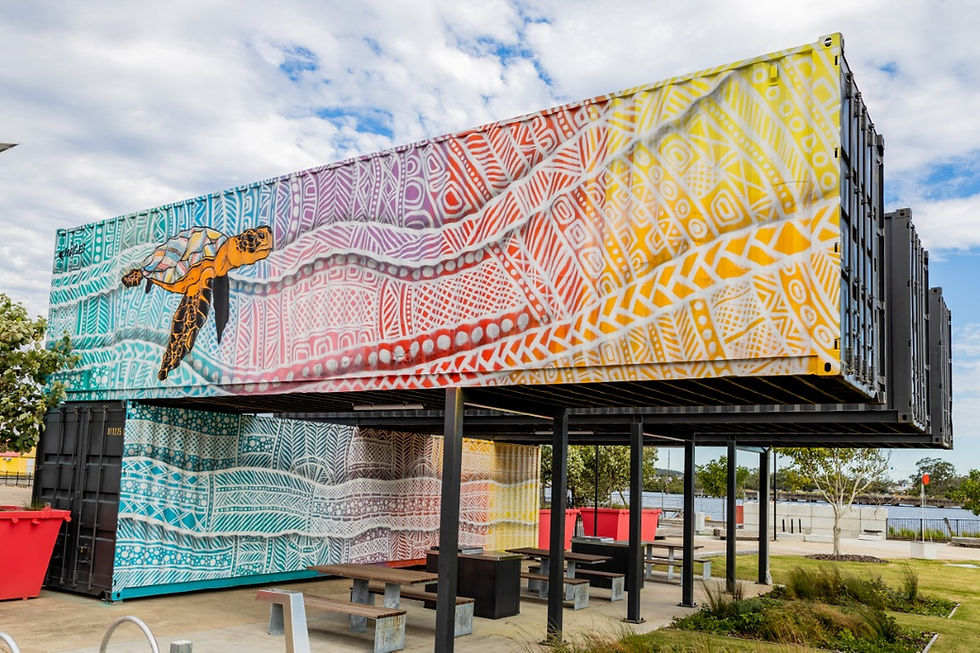Celebrating Country: What We Learned at the Indigenous Placemaking Community of Practice
- Place Leaders Asia Pacific

- Jul 23
- 8 min read
Earlier this month at the July Indigenous Placemaking Community of Practice we heard the stories of -
A mullet run carved into concrete, a story thousands of years old that travels with drivers heading to Sydney airport. Created by the ReRight Collective with Elders Uncle Steven Russell and Aunty Phyllis Stewart, and physically embedded into the Sydney Gateway by artists, engineers and urban designers all working together (across “many, many meetings”!)
A 20-year-old Birpai artist seeing his first public artwork, Nyaagilbaa (Looking Place) unveiled at a whale-watching platform as part of the Tacking Point Lighthouse in Port Macquarie. Council staff spent months building trust and creating space for emerging First Nations artists. The work, sandblasted into a curved concrete retaining wall near the entrance of the site, is a topographical representation of Birpai Country with its ridgelines, flow, and strength.
A street named Yerrol, the traditional name for a riverine rainforest pocket along the Brisbane River because, long before there were streets to name or urban renewal and Olympic infrastructure, that’s how this place had always been known by the Turrbal and Yuggera peoples. It was a gathering place, a hunting ground, and a site of welcome.
We heard how three award-winning projects are changing the way indigenous placemaking happens across the region: Sydney Gateway, Tacking Point Lighthouse, and Northshore Brisbane. We loved the way the projects - and the incredible women who shared them - revealed and respected Country.
Timed for NAIDOC Week 2025, this was about listening respectfully and collectively and that’s what made the July Indigenous Placemaking Community of Practice hit us all a bit differently.
Place Leaders Asia Pacific is your community built by placemakers, for placemakers. Our speakers are your collaborators. Connect with them on LinkedIn and reach out to learn more. Great placemaking happens when we share, support, and learn from each other.
Northshore Brisbane - Economic Development Queensland
The Magic’s Not in the Document, It’s in the Trust
Vanessa Altun from Economic Development Queensland (EDQ) kicked things off with Northshore Brisbane, Queensland’s largest urban renewal precinct, and the winner of the Indigenous Placemaking Award.

A Different Kind of Urban Renewal
Vanessa was clear: this project started with listening.
“We didn’t know what we didn’t know,” Vanessa admitted. “We needed help, so we asked for it.”
That help came in the form of the Traditional Owner Engagement Protocol, co-designed with Traditional Owner groups - particularly families with ties to Yerrol, and cultural consultancy Jagera Daran.
Vanessa emphasised that the protocol itself wasn’t the goal, it was the process of making it: sitting down, building relationships, and learning the long history of Yerrol, the gathering place that existed long before Northshore had a postcode. This happened over many months of yarning, trust-building and shared meals, mapping cultural context as well as responsibilities - on EDQ’s side - to act with integrity.
Outcomes Grounded in Country
80% native forest canopy is now the goal for new landscaping, based on cultural plant use.
Streets bear traditional names, grounded in verified local history.
Yerrol Social Enterprise was launched - a First Nations-led cultural business creating art and design on Country.
The Birrunga Gallery was welcomed as a creative anchor tenant, with exhibitions, workshops, and events.
Public art, performance, and ceremony are now part of Northshore’s everyday identity.
Third-party developers must produce First Nations Benefit Plans to secure EDQ approval.
Public art, cultural ceremonies, and procurement policies that centre First Nations businesses

One of the most powerful moments came when Vanessa reflected on the team’s initial lack of confidence, but the real shift happened when they realised we didn’t need to know everything, they just needed to be willing to learn.
Takeaways for Practice
The Protocol wasn’t copied from somewhere else, it emerged from the the people over time (‘trust before templates’).
Internal discomfort is a signal and acknowledging that uncertainty led to better questions and listening, and stronger cultural outcomes.
Trust takes time but multiplies the impact.

Where the Sky Meets the Earth and Sea - Cultural Capital
Art That Speaks at 80km/h
Sydney Gateway is an an arterial transport corridor linking Sydney Airport to the broader city and isn’t the kind of place you’d expect to find Culture. It’s all infrastructure: overpasses and noise barriers but as Hannah Molyneux from Cultural Capital shared, something remarkable took shape and was Highly Commended for Indigenous Placemaking Award.

Through a collaborative commission led by Cultural Capital, artists Carmen Glynn-Braun and Dennis Golding of the ReRight Collective worked with Elders Uncle Steven Russell and Aunty Phyllis Stewart to embed real, living story into hard infrastructure.

The project, Where the Sky Meets the Earth and Sea, draws on cultural practices of weaving, fishing, and seasonal movement through Country. Patterns ripple across retaining walls echoing the Mullet Run.
“The story of the Mullet run, special fishing, weaving, craft, botany and the connection and flow of the seasons...” - from the Award nomination
Designing Within Limits
This project was a case study in constraints and finding a way forward through story.
“We are thinking of maintenance. We’re thinking of cost. We’re thinking of high-performance materials... we don’t have colour... and again, the fact that an emerging artist was able to work in this way is just so amazing...” - Hannah Molyneux
Artists as Co-Authors and Partners
What made it work was a project team that backed the artists at every step, and a very conscious engineering decision not to treat the artists as subcontractors, but as co-authors of the space.
“My job is not to be an artist. My job is to champion the artists… and decentre myself.” - Hannah Molyneux
The team wanted this work to be known and felt as a gateway to culture for thousands of drivers and international visitors each day.
“The artists felt a heavy burden to tell a meaningful cultural story in such a prominent, heavily used roadway. They retained the integrity of the stories entrusted to them by community throughout the process.” - from the Award nomination
“Symbols and motifs reflect cultural practices of fishing, weaving and use of plants at nearby Gamay (Botany Bay)... The goal was to offer a tangible sense of Connection to Place...” - from the Award nomination
Takeaways for Practice
Don’t wait for the 'perfect site' to embed culture because even a transport corridor can carry story.
Treat artists and Elders as equals in the design process.
Build in the time for trust. This collaboration worked because there was space for listening and shared authorship.
Culture can be felt, not just explained. As Hannah put it, “... sometimes, the shape of a line is enough to remind you that this place holds stories.”
Tacking Point Lighthouse - Port Macquarie Hastings Council
Watching With Respect
Port Macquarie’s Tacking Point Lighthouse is a treasured spot for whale watchers and sunset seekers but for years it was almost impossible to access for people with mobility challenges.

A collaborative effort led by Port Macquarie Hastings Council (PMHC), alongside the Sunrise Rotary Club, disability advocates, and the local Birpai community, turned a steep, crumbling, and exclusive space into an accessible boardwalk and viewing platform, gaining a Highly Commended Award for Place Governance.
Lucilla Marshall and Vivian Mitchell shared how the project began with listening and learning. From over 500 community engagements to on-Country meetings with Elders, the design evolved around the community’s priorities: accessibility, cultural respect, and ecological resilience.
“At first, we planned for a single artwork,” Lucilla said, “but the responses were so strong, and the designs so beautiful, we knew we had to honour both.”
They told the story of how Boundless, by Rachel Cross, sits at the whale-watching platform. Made from corten steel, and depicts dolphins and a breaching whale as a a living reminder of the movement through Sea Country. Nyaagilbaa (Looking Place), created by 20-year-old emerging artist Tarran Marr-Harris, is sandblasted into the concrete retaining wall, offering a topographic tribute to Birpai land and waters. Together, these artworks have transformed the site into a place of cultural reflection and intergenerational welcome.
Support First Nations artists through Culturally Safe and Flexible Processes
Vivian shared how EOI processes were redesigned to ensure Birpai artists felt supported to submit concepts that reflected their deep connection to Sea Country.
“We built up that trust, that really great level of relationship that then allowed people to feel so confident to create an artwork or submit a concept that really reflected what Sea Country and the site meant to them.” - Vivian Mitchell
And when both Rachel and Tarran's works were selected?
“They were just blown away,” Vivian said. “We cried together the day they saw their art, permanently part of this land.”
From a technical perspective, the project used Fibre Reinforced Plastic for the boardwalk, a sustainable material with a 100-year lifespan. The gradient is wheelchair-friendly. Resting platforms make it welcoming for everyone from toddlers to elders.

Economic outcomes, too
An extra 121,000 visitors over five years and more than $8 million in economic uplift.
Takeaways for Practice
EOIs must be tailored to make room for lived connection to place.
Indigenous artworks here aren’t decorative, they’re topographical, ecological, and narrative tools that honour Country
Cultural inclusion and economic uplift can go hand in hand.
Let emotion guide what data can’t measure. On opening day, people who’d never before made it to the top stood hand-in-hand, watching the whales, meaning so much more than the KPIs ever could.
“This Isn’t a Moment. It’s a Movement.”
Throughout the evening, the Zoom chat held some big questions:
“How do we tell these stories to people moving through so quickly?”
“Is cultural IP being safeguarded during community engagement?”
“Did your team receive cultural education before beginning the work?”
“How do we share these stunning, layered, meaningful stories more widely?”
The answers may not be one-size-fits-all, but a few themes are became clear:
Trust takes time.
Artists are not subcontractors and need support, not just scope.
Protocols don’t need to be perfect, they need to be honest and evolving.
Connection to Country isn’t an add-on.
Keep Listening and Learning
NAIDOC Week 2025 invited us to honour “the next generation: strength, vision, and legacy.”
Our speakers showed us what that can look like in placemaking when we centre on relationships vs. rushing, reciprocity vs. rollout, and responsibility vs. rhetoric.
Join the Movement: Place Leaders Asia Pacific 2025-26 Membership
By joining (or renewing), you’re helping us continue to champion great places, support your work, and grow a stronger community across the region. As a member, you'll access over $6000 in benefits. Find out more at www.placeleaders.com/membership
Here’s what your peers are saying about Place Leaders Asia Pacific
“Absolutely awesome to be at the 2025 Place Leaders Asia Pacific Summit!” - Andrew Coward, Reactivate Consulting
“Such a great group of place leaders! Well done for pulling together such a great event.” - Alice Percy, City of Darwin
“Fabulous event! Thank you.” - Christine Lane, Gold Coast City Council
“Amazing conference. Thanks to the team at Place Leaders Asia Pacific!” - Julie Ryland, Hornsby Shire Council
"Attending the Place Leaders Asia Pacific summit was an incredible experience." - Erin Marchant, Ipswich City Council
“What a Summit! Thank you, Place Leaders Asia Pacific, for such an inclusive, immersive experience.” - Joyce Louey, City of Marion
“The most relevant place training I’ve encountered...” - Chris Patfield, City of Parramatta Council
“[Place education that is] expert-led, easily digestible, and focused...” - Brendan Gavin, Northern Beaches Council














































Comments